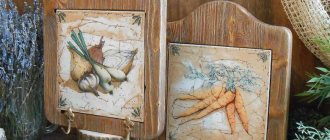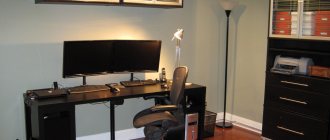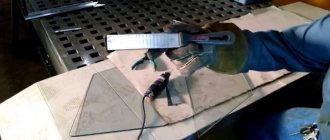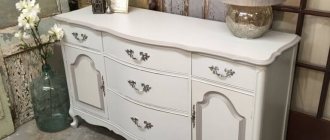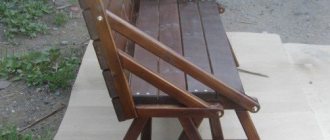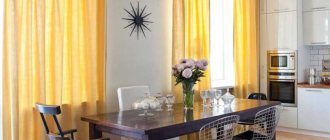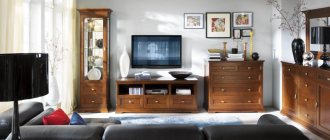Benefits of painting
Under the influence of unfavorable conditions, paint peels and crumbles. Old furniture is a carrier of a special atmosphere. Many homes have chairs, tables, armchairs or sofas waiting to be restored. When renovating woodwork, if you properly paint the table white, it will last for many more years. Many products of cabinetmakers of the past are recognized as masterpieces, but over time they need restoration. The legs of the table become loose, the wood wears away, it swells from moisture, rots, turning into dust. If it was not damaged by fungus, it is not too late to fix everything.
Note! Modern compositions will help restore an antique product, giving it an “antique” look. New enamels, stains and impregnations will help restore and decorate any handmade product.
It is impossible to explain in a nutshell how and what is the best way to paint a wooden table, but any modernization provides undeniable advantages:
- updating the appearance of the product or improving aesthetic properties;
- protection against soaking, rotting and fungal damage;
- updating the shade and enhancing the texture of wood;
- the ability to combine several products with a single color or decorative technique;
- the table will fit organically into a modern interior;
- When painting a table, parts are restored or minor repairs are made to individual components.
With a creative approach, you can transform the entire kitchen furniture - the room will look completely different. You can not only repaint an old table white, but also effectively decorate all work surfaces. After restoration, the countertops can be reliably “preserved” with flexible glass or a multi-layer water-repellent composition. All stages of preparation are easy to do yourself.
Comparison of the table before and after restoration
Paint selection
Depending on the type of wood and general condition, upgrading and painting an old table can be done in different ways:
- varnishing with pre-coating with stain to enhance color and texture;
- traditional painting;
- sanding wood (removing the old layer), coating with wax polish;
- decoration (craquelure, brushing, decoupage).
Before you paint a wooden table with your own hands, it is recommended to disassemble it. For each method, a special composition is selected. For traditional coloring, experts recommend:
- Acrylic paint. The environmentally friendly water-based composition is considered universal, non-toxic, and dries quickly. Available in different packaging - in cans, for painting tools. Large range of shades at an affordable price.
- Nitroenamel. It is toxic, but has the fastest drying rate and has an affordable price. It is advisable to carry out all work outdoors in the shade - ultraviolet radiation destroys the color and structure of the paint.
- Alkyd enamel. It has a specific smell. Painting the table will not cost much; the coating will reliably protect the wood from the destructive effects of moisture. Over time, the paint wears off, and the tabletop will have to be renewed after a while.
- Water-based paint. Also used for renovation of kitchen furniture. It is non-toxic, has high hiding power, and does not form sagging. The coating provides good protection from moisture and sunlight, but is gradually destroyed during cleaning (under the influence of abrasive particles).
- Oil paint. “Classics”, which for a long time had no alternative on our territory. It is well absorbed into the prepared base (previously the wood was opened with drying oil), but it has a specific smell, lays down with sagging, and gives streaks.
Note! The choice of composition should also be guided by the composition of the wood. Oily paints and wax polishes are more suitable for conifers (resin oozes from the pockets of fresh boards for a long time). For hardwood – water-dispersed paints.
The overall design of the room determines what color to paint a white table or a whole set of stools:
- rich tones will accentuate the improved furniture (yellow and orange are appetizing, blue and lilac are dull, green tones are quite neutral);
- white and black are the optimal background for other shades and textures. The legs of the table can be painted white to match the decoupage of the table top, or take black varnish to match the colored design of the top;
- metallic paints are used for specific decoration tasks (gold plating, metallic or coating moldings with imitation copper and bronze).
Please note: Detailed instructions for reviving old furniture with your own hands
Painting a white table in a beautiful color and decorating the tabletop will help solve the issue of replacing old furniture. Using the same method, you can update a set of stools, a kitchen corner or an antique handmade set.
Acrylic paint for wood
Nitroenamel for wood
Alkyd enamel for wood
Water-dispersion paint for wood
Oil paint for wood
Choosing a color scheme for an old table
The choice of color depends entirely on the owner of the table and his preferences. This could be bright, rich shades, creating the illusion of a wooden texture, painting the countertop white or metallic, etc.
- Juicy tones: light green, yellow, scarlet, blue
Such color solutions will “fit” well into a modern style, where such furniture will become a bright detail of the interior of the room.
- White or black color
This is the best option for those owners who are pretty tired of the “native” color of the table or countertop and decided to make it more “neutral”.
This solution will suit any interior and will become its laconic highlight. When painting a table correctly, its wooden texture will be hidden under a uniform layer of paint.
Painting all furniture or its parts in metallic colors is a successful solution for design in a classic or high-tech style.
Necessary tool
Many enamels have an unpleasant odor and take a long time to dry, so it is better to paint in a non-residential area. The floors in a small workshop or garage are covered with film or old newspapers so that you don’t have to clean up traces. For coloring you will need:
- fungicide or antiseptic for impregnating wood;
- wood primer (white or transparent);
- paints or varnish;
- solvent;
- wood putty;
- means for removing the old layer.
It is advisable to restore the table in a separate room on a flat, hard surface. In the process of preparing the kitchen table for painting, it is important to mark the legs, drawers and other parts with numbers so as not to get confused during assembly.
Important! If the legs are not loose, it is better not to disassemble the product. When the legs of the table are wobbly, it is better to disassemble it, it will be more convenient to paint. After assembly, it is possible to strengthen it with a frame or corners, significantly extending its service life.
Before painting the table, prepare tools and working equipment:
- Screwdriver (needed during disassembly of the product).
- Working tools (roller with attachments, paint brushes, spatulas).
- Work clothes and protective equipment (goggles, gloves, respirator).
- Auxiliary containers for preparing paint, a container for applying paint with a roller.
- Special compositions for decorating tabletops.
- Fine-grained sandpaper, sponge, masking tape, rags.
Helpful advice! Sometimes a beautiful product only needs to be replaced with a tabletop or 2-3 legs. You can turn to a carpentry workshop for blanks. It is better to change the legs all at once so that they do not differ in texture, shade of wood, or type of processing.
Antiseptic for wood
Wood putty
Primer for wood Please note: Painting leather
Necessary materials
The materials used to paint old boards must be of high quality. You need to choose only high-quality materials for painting and priming.
For the entire restoration or painting process you will need:
- Antiseptic for wooden surfaces;
A wood antiseptic is necessary to protect wood from mold and fungi, the so-called blue stain, and harmful insects.
The primer helps improve the adhesion of the coating to the boards and reduces paint consumption.
Wooden products need protection. Varnishes are used for this purpose.
When performing repair work, we inevitably deal with solvents for varnish, enamel, and paints.
Masking tape is a tape based on a slightly rough paper layer.
You need to cover the area where you will paint the table with newspapers.
It is not the smell itself that is harmful, but the volatile compounds in the paint - solvents. They are toxins for the nervous and hematopoietic systems.
Surface preparation and painting
- Disassemble the product (remove drawers, unscrew legs, remove decorative trims), cover metal fittings or inserts that are difficult to dismantle with masking tape.
- Wash all parts with warm soapy water, wipe, and dry at room temperature.
- Using protective products, begin the restoration process by sanding the surfaces or removing old paint.
- Fill cracks and chips with putty.
- Treat all surfaces with an anti-rotting compound, then with a primer, after drying, sand with emery and use a vacuum cleaner to remove dust.
- Prepare the room for painting by covering the floors, put on work clothes, and begin processing the table.
- Before working with paint in a can, you need to shake it well and spray it at a distance of 20-30 cm. Before painting, the composition is slightly diluted with a solvent in the proportion indicated on the packaging.
- After the first layer has dried, it is painted again; usually 2-3 coats are enough for high-quality detailing, but it can be secured with a colorless varnish.
- After drying (at least 24 hours), remove the tape and assemble the table; after 2-3 days it can be used.
Preparing the surface for painting
All irregularities should be filled with putty.
Painting process
Decorating the table surface
There are several ways to decorate countertops, each with its own technology and paint composition.
- Craquelure (from the French craquelure “crack”) is a fine network of cracks, achieved by using decorative varnish (two-phase or single-phase). The pattern of an artificially aged surface depends on the composition, drying temperature and speed of “setting” of the varnish.
- Painting with tension of guipure, tulle or openwork mesh with quick work with a roller on a prepared surface. If the background is darker or lighter, the end result is a beautiful design that can be fixed with varnish or flexible glass.
- To modernize furniture using the decoupage technique, you will need special napkins with a pattern, special glue, and acrylic varnish.
- Brushing or a special method of aging is carried out with a special composition. Wood with an expressive texture is suitable (oak, ash, pear, walnut). MDF panels and veneer are not suitable.
- Patina coating is another way of decoratively “aging” furniture.
Pay attention to: How to paint a chair at home
Chemical compositions and coloring impregnations are widely used to make the texture more expressive. The simplest method is self-adhesive vinyl or flexible glass over the tabletop pattern.
Table decoration option
How to age wood
Brushing wood with your own hands, giving it the look of aged wood, is quite simple.
Not all types of wood lend themselves to this type of finishing.
It is better to take materials with a pronounced texture. These are ash, pine, oak. Exotic species - beech, maple - do not lend themselves well to this type of processing. They do not do brushing on MDF panels.
To obtain the desired effect, we treat the old surface with a metal brush, grinder or drill with a wire attachment.
During processing, you must wear safety glasses and a mask.
Chemical method
We clean the surfaces with sandpaper and wipe with ammonia to darken. The texture of the wood will become more pronounced and distinct.
If you overdo it, the wood will become loose.
We sand the top of the treated furniture with an abrasive, go through it again with fine-grained sandpaper and varnish.
Patination
Apply patina to the treated surface. This could be stain or other means. Deep pores will darken against a light background.
You can select materials to paint in the desired color and completely cover the surface, wait until it dries, then carefully remove part of the top layer with a sponge.
Enamel
We apply the desired shade of enamel to the wood, wait until it dries, and paint the second layer with a lighter shade with a liquid consistency.
After drying, we go over it with sandpaper.
The first layer will appear on the furniture. You will get the effect of aging and wear.
The surface is varnished in 2 or 3 layers and wiped with a rag until shiny.
